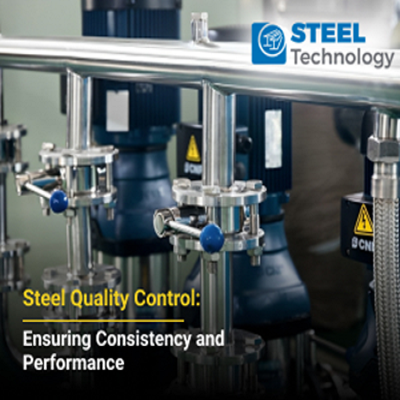Steel Quality Control: Ensuring Consistency and Performance

Introduction:
Steel is super important in our daily lives. It's in our buildings, the cars we drive, and even in the stuff we use at home. It's really strong and lasts a long time, which is why we use it so much. But here's the thing: not all steel is the same. How it's made and what it's made of can really change how good it is. That's why we have to be really careful about checking how good the steel is before we use it for things. This article is all about how we check steel to make sure it's good enough for what we need it for. We'll talk about the important things we look at and why it's so important to make sure the steel is always top-notch.
Understanding Steel Quality Control:
Steel quality control refers to the systematic measures employed during the manufacturing process to verify that the produced steel meets the desired specifications and quality standards. It encompasses a series of evaluations, tests, and inspections carried out at various stages of steel production, from raw material procurement to the final product. The primary objective is to identify and rectify any deviations or defects that might compromise the integrity, strength, or functionality of the steel. By adhering to rigorous quality control protocols, manufacturers can uphold the reliability and credibility of their steel products, fostering trust among consumers and stakeholders.
The Significance of Consistent Steel Quality:
Consistency in steel quality is paramount for ensuring its reliability and predictability in diverse applications. In construction projects, for instance, the use of inconsistent steel can lead to structural weaknesses, jeopardizing the safety of the entire edifice. Similarly, in the automotive and aerospace industries, where precision and performance are critical, any deviation in steel quality can result in mechanical failures and compromised safety standards. Even in everyday household items, such as kitchen appliances and cutlery, the use of substandard steel can impact their longevity and functionality. Therefore, maintaining a consistent standard of steel quality is imperative across all sectors to guarantee the optimal performance and safety of the end products.
| Read More: Streamlining Steel Supply Chains for Efficiency and Savings |
Key Parameters in Steel Quality Control:
When we check if steel is good enough, we look at some important things. These things help us make sure the steel is just right. We don't want to use steel that isn't good. So, we look at:
- What the steel is made of: We check what stuff is in the steel to make sure it's good.
- How strong it is: We test how strong the steel is, so it doesn't break easily.
- What it looks like up close: We use special tools to see if the steel looks okay and doesn't have any strange things in it.
- How well it's made: We check if the steel is the right size and shape, so it fits where we want to use it.
- What the outside is like: We look at the outside of the steel to make sure it's smooth and looks good.
- Checking inside without breaking it: We use special machines to see if there's anything wrong inside the steel without breaking it.
These things help us make sure the steel is good for what we want to use it for. These parameters include but are not limited to:
1. Chemical Composition Analysis: The chemical composition of steel significantly influences its properties, such as strength, durability, and corrosion resistance. As a result, precise analysis of the elemental composition is crucial to verify whether the steel meets the specified grade requirements.
2. Mechanical Properties Testing: The mechanical properties of steel, including its tensile strength, yield strength, and impact resistance, determine its performance under different conditions. Conducting rigorous mechanical testing helps ascertain whether the steel possesses the necessary mechanical attributes for its intended application.
3. Microstructure Examination: The microstructure of steel, which includes its grain size and phase distribution, directly impacts its mechanical and physical properties. Through microscopic analysis, manufacturers can assess the homogeneity and integrity of the steel's microstructure, ensuring that it aligns with the desired characteristics.
4. Dimensional Accuracy Assessment: In many applications, precise dimensional accuracy is crucial for seamless integration and functionality. By employing advanced measurement techniques, manufacturers can verify whether the dimensions of the steel components adhere to the specified tolerances, thereby preventing any discrepancies that might hinder the assembly or operation of the end product.
5. Surface Quality Inspection: The surface quality of steel is essential for aesthetic appeal, corrosion resistance, and overall performance. Through meticulous surface inspections, manufacturers can identify any surface irregularities, such as cracks, pits, or roughness that could potentially compromise the steel's integrity and longevity.
6. Ultrasonic and Non-Destructive Testing: Ultrasonic testing and other non-destructive techniques are instrumental in detecting internal flaws or defects within the steel without causing any damage to the material itself. These methods enable manufacturers to identify hidden imperfections, such as voids, inclusions, or discontinuities, which might affect the structural integrity of the steel.
Implementing Robust Quality Control Processes:
To ensure the effectiveness of steel quality control, it is imperative for manufacturers to implement robust processes and standards throughout the production cycle. This involves the integration of advanced technologies and methodologies that facilitate precise and comprehensive evaluations of the steel's properties and characteristics. Additionally, establishing a quality management system that adheres to international standards, such as ISO 9001, can serve as a framework for maintaining consistency and continual improvement in the manufacturing processes.
Moreover, fostering a culture of quality consciousness among the workforce is crucial for upholding stringent quality control measures. Training employees to recognize the significance of adhering to quality protocols and encouraging their active participation in the quality assurance procedures can significantly enhance the overall quality control efforts within the manufacturing facility.
Embracing Technological Advancements in Steel Quality Control:
Because technology is getting better quickly, how we check if steel is good has changed a lot. This helps the people who make the steel check it more carefully and in better ways. New things like machines that look at the steel using special lights, machines that use lasers to check the steel, and ways to take pictures of the steel have made it much easier for the people making the steel to make sure it's good.
Automated systems equipped with artificial intelligence and machine learning capabilities have the capacity to streamline the quality control process, reducing human errors and expediting the detection of potential defects or deviations. By leveraging these technologies, manufacturers can enhance the accuracy and reliability of their quality control assessments, thereby minimizing the risks associated with substandard or non-compliant steel products.
Ensuring Regulatory Compliance and Industry Standards:
In the world of making steel, following the rules set by the government and the industry is really important. We have to make sure we do what we're told to make steel that is safe and works well. There are some groups that make these rules, like the American Society for Testing and Materials and the International Organization for Standardization. Following these rules helps us make sure that the steel we make is safe and does what it's supposed to do.
Furthermore, staying abreast of the evolving regulatory landscape and proactively adjusting the quality control processes to align with updated standards is critical for maintaining a competitive edge in the industry. By actively participating in industry forums, conferences, and collaborative initiatives, manufacturers can gain insights into the latest developments and best practices in steel quality control, enabling them to continually enhance their manufacturing processes and stay ahead of the curve.
The Role of Third-Party Certifications and Audits:
Third-party certifications and audits play a vital role in validating the efficacy of a manufacturer's quality control processes. Engaging reputable certification bodies and independent auditors to assess the compliance of the manufacturing facility with the established quality standards not only bolsters the credibility of the steel products but also instills confidence among customers and stakeholders regarding the manufacturer's commitment to quality and reliability.
Getting certifications is like getting a special stamp that shows we're doing things the right way. Certifications from groups like the International Organization for Standardization (ISO) show that we're following the rules for making good quality stuff. There are also other certifications just for the steel industry, like the one from the American Petroleum Institute (API) for making steel that's used in oil and gas. Having these certifications can help us sell our steel to more people and show that we know what we're doing.
In Conclusion:
Steel quality control is a cornerstone of the manufacturing process, ensuring that the produced steel exhibits the necessary properties and characteristics to meet the stringent demands of diverse applications. By prioritizing consistency, implementing robust quality control processes, embracing technological advancements, and adhering to regulatory standards, manufacturers can uphold the integrity and reliability of their steel products, fostering trust and confidence among consumers and stakeholders. As the global demand for high-quality steel continues to rise, maintaining a steadfast commitment to stringent quality control measures remains imperative for the sustained growth and success of the steel industry.











